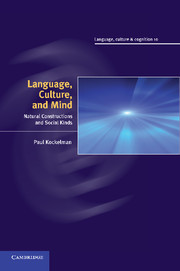Book contents
- Frontmatter
- Contents
- List of illustrations
- Acknowledgements
- 1 Language, culture, mind: emblems of the status human
- 2 Inalienable possessions: what hearts, mothers, and shadows have in common
- 3 Interclausal relations: how to enclose a mind by disclosing a sign
- 4 Myths about time and theories of mind: why the moon married the sun
- 5 Other minds and possible worlds: when psychological depth is dialogical breadth
- 6 Interjections: why the centre of emotion is at the edge of language
- 7 Conclusion: natural constructions and social kinds
- Appendix A Transcription conventions
- Appendix B The Marriage between the Sun and the Moon
- References
- Index
3 - Interclausal relations: how to enclose a mind by disclosing a sign
Published online by Cambridge University Press: 04 May 2010
- Frontmatter
- Contents
- List of illustrations
- Acknowledgements
- 1 Language, culture, mind: emblems of the status human
- 2 Inalienable possessions: what hearts, mothers, and shadows have in common
- 3 Interclausal relations: how to enclose a mind by disclosing a sign
- 4 Myths about time and theories of mind: why the moon married the sun
- 5 Other minds and possible worlds: when psychological depth is dialogical breadth
- 6 Interjections: why the centre of emotion is at the edge of language
- 7 Conclusion: natural constructions and social kinds
- Appendix A Transcription conventions
- Appendix B The Marriage between the Sun and the Moon
- References
- Index
Summary
Emblemeticity, iconicity, and intentionality
The interclausal relations hierarchy is a cross-linguistic pattern whereby the ‘closer’ two events are construed semantically, the ‘tighter’ two verbs are bound grammatically. Take the following two sentences: 1) Dave believes that John was a warlock; 2) Janet wants to become a witch. Each of these sentences has two verbs, the first of which refers to a mental state (believe, want), and the second of which refers to a state or state-change (be, become). And each of these sentences might be understood as representing two events: first, there is the event of Dave's believing or Janet's wanting; and second, there is the event of John's being a warlock or Janet's becoming a witch. Crucially, just as sentence (1) involves two relatively distinct clauses (each verb has its own subject, and is inflected with a different tense: Dave and John, present and past), the state of affairs represented by this sentence seems to involve two relatively unrelated events (believing and being). And just as sentence (2) involves a single clause (the two verbs share a single subject and tense inflection: Janet, present), the state of affairs represented by this sentence seems to involve two relatively related events (wanting and becoming). In short, the more a state of affairs is construed as involving two separate events (causally and logically), the more the construction representing that state of affairs is encoded with two separate clauses (morphologically and syntactically).
- Type
- Chapter
- Information
- Language, Culture, and MindNatural Constructions and Social Kinds, pp. 52 - 84Publisher: Cambridge University PressPrint publication year: 2010



